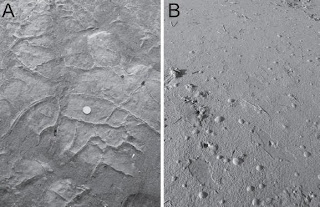Having looked at the Nature paper some more, another thing springs to mind.
Scale.
Here are some of the structures as figured in the paper.
y.jpeg)
Note the scale bars against each example. Those scale bars represent 5 mm! That's right millimetres!
These things are small. Especially the central area that contains the folding.
Now, compare that with the examples of bubbles in microbial mats
There is no scale, but some of the bubbles must be at least the size of the central folded area of the specimens figured in the Nature paper. This means we have structures documented today in microbial mats that equate in size to the central area of the structures from Gabon.
Now, what would happen to a gas or fluid filled bubble if it were covered with sediment and the gas/fluid escaped? It would deflate. Not deflate flat, as the microbial structure would be too thick. Maybe it would fold on itself just like the central structure in the specimen in row two above? Especially if there was an encouraging push from overlying sediment.
I'm even more convinced that the Gabon structures are microbial mats.
UPDATE 2
Diana G. Cuadrado and Natalia V. Pizani. (2007) Identification of microbially induced sedimentary structures over a tidal flat. Latin American Journal of Sedimentology and Basin Analysis. v.14 n.2 La Plata ago./dic. 2007

What a kill-joy you are, but probably right sad to say.
ReplyDeletethak you very much for your posts.
ReplyDeleteI know very little about precambrian so my opinion is not the one of an expert, but your proofs are various and well documented, so I think that it's much easier that you are right than you are wrong.
What I don't understand (if, as I think, you're right) is why in a so great number of scientist (21 people!) there is no one thinking a solution as you
Aldo,
ReplyDeletevery few of the authors have a background in palaeontology.
Philippe Janvier has a distinguished record of contributions, but mainly on the origin of vertebrates.
Stefan Bengtson also has a distinguished record, but mainly on Cambrian and later organisms.
They are both firmly among the metazoa!
Emmanuelle Javaux has worked on microfossils, but mainly works on biogeochemistry, and Donald
Canfield has worked on modern microbial mats, but mainly works on biogeochemistry.
Dolf Seilacher, who has worked on Proterozoic forms and traces, has been reported in the press as not accepting the author's conclusions.